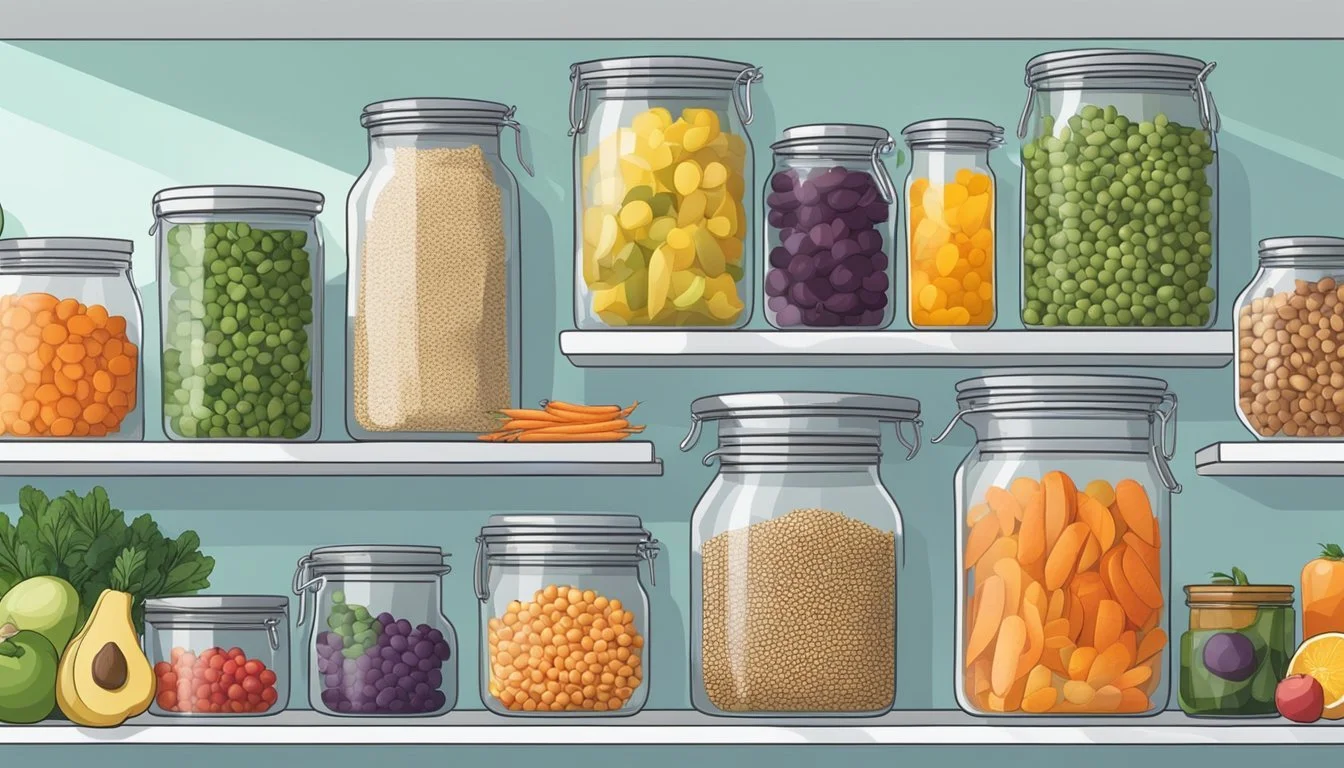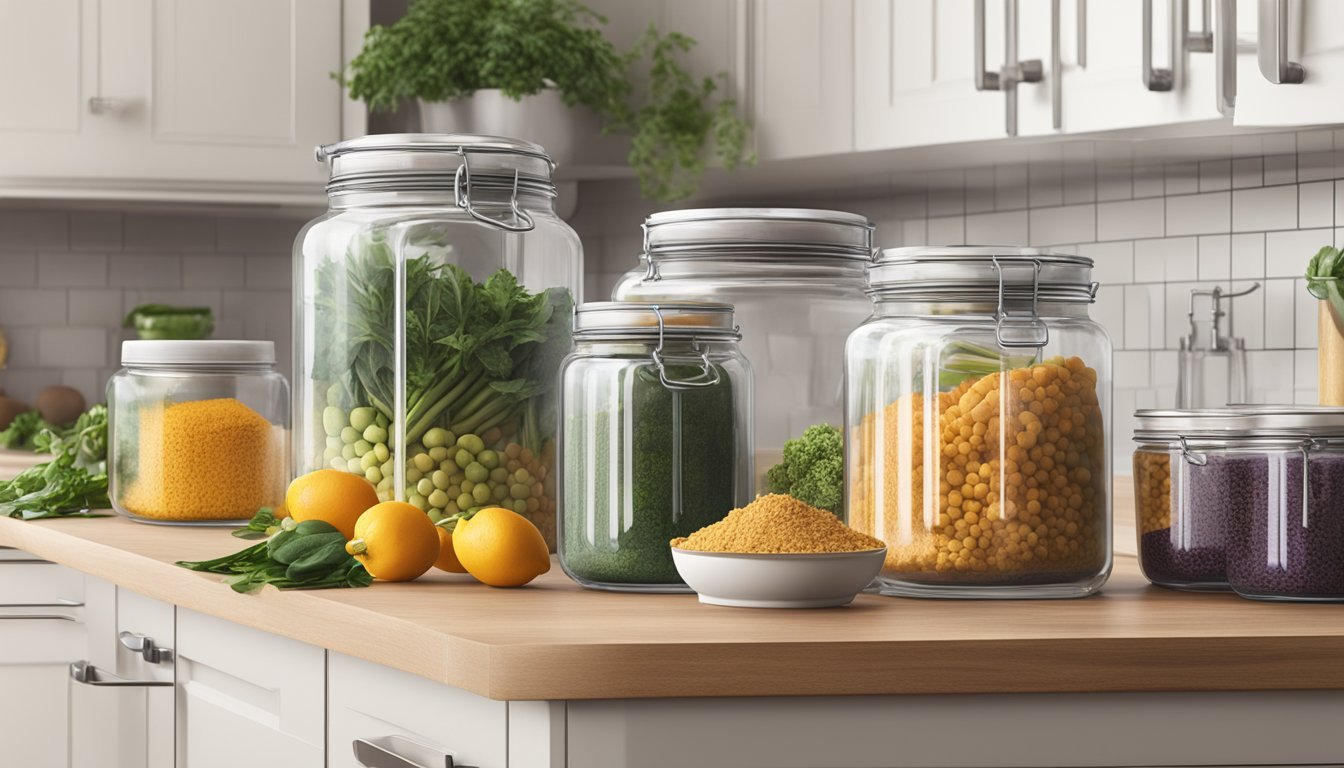Organizing Your Kitchen for a Plant-Based Diet
Efficient Space Management Tips
Adopting a plant-based lifestyle requires thoughtful consideration of the foods one keeps on hand and the way in which a kitchen is organized. As individuals transition to a plant-based diet, it becomes essential that their kitchen environment supports their dietary habits and makes plant-based eating convenient and enjoyable. The key to maintaining a healthy and sustainable plant-based lifestyle lies in the organization of the space where meals are prepared.
A well-structured kitchen that caters to a plant-based diet will often include a variety of fresh vegetables, whole grains, legumes, nuts (What wine goes well with nuts?), and seeds, strategically stored for easy access and optimal freshness. The organization is crucial, with items typically arranged according to the frequency of use and the type of meal preparation they are intended for. Clear storage solutions and labeling can streamline the cooking process and ensure that everyone in the household is aware of where to find and replace specific ingredients.
Moreover, having the right kitchen tools can simplify the preparation of plant-based meals. From blenders and food processors to proper cutting boards and knives, equipping the kitchen with devices that handle plant foods efficiently can enhance the overall cooking experience. This structured approach not only supports those who have fully embraced veganism but also aids those incorporating more plant-based meals into their diets, making it easier to stick to healthful eating habits.
Understanding Plant-Based Diets
Plant-based diets focus on foods primarily from plants, including fruits, vegetables, nuts, seeds, oils, whole grains, legumes, and beans. It doesn't mean that someone is vegetarian or vegan and never eats meat or dairy; rather, one is proportionately choosing more of their foods from plant sources.
Health Benefits and Nutrition
Plant-based diets are rich in fiber, vitamins, and minerals that support health and wellness. Nutrition derived from plant-based diets is often comprehensive, delivering an array of nutrients essential for the body. Consuming a variety of whole grains like quinoa, oats, and farro provides sustainable energy and aids digestive health due to the high fiber content. Legumes such as lentils, chickpeas, and black beans are excellent sources of protein and fiber, making them staples in a plant-based kitchen.
Iron is abundant in leafy greens, while nuts and seeds like almonds, cashews, walnuts, hemp, chia, and flax seeds offer healthy fats, protein, and vital micronutrients, including omega-3 fatty acids. A diet emphasizing these plant-based components can contribute to improved heart health, reduced risk of certain chronic diseases, and enhanced overall health.
Essential Ingredients for a Plant-Based Kitchen
A well-stocked plant-based kitchen will usually contain a diverse array of:
Whole Grains: Such as rice, quinoa, oats, and farro that serve as the foundation for hearty meals.
Nuts and Seeds: Including almonds, cashews, walnuts, hemp seeds, chia seeds, and flax seeds for snacking or adding to meals for extra nutrition.
Legumes: Lentils, chickpeas, and black beans are important for their protein content and versatility in recipes.
These foods form the backbone of plant-based eating and can be combined in a multitude of ways to create nutritious, satisfying dishes that support a healthy way of eating.
Setting Up Your Plant-Based Pantry
A well-organized plant-based pantry is crucial for maintaining a healthy, vegan lifestyle. It should be stocked with essential staples and organized for easy access and optimal freshness.
Pantry Staples to Stock Up On
A plant-based kitchen revolves around a variety of nutrient-rich and versatile ingredients. Ensure these vegan pantry staples are always on hand:
Grains and Pastas: Whole wheat flour, oat flour, and a selection of pasta like whole-grain spaghetti or penne.
Canned Goods: Canned beans, tomato sauce, and tomato paste are convenient for quick meals.
Broth and Oils: Low- or no-sodium vegetable broth, coconut oil, olive oil, and avocado oil serve as bases for cooking.
Spices: Essential spices include cumin, turmeric, cinnamon, garlic powder, onion powder, chili powder, and oregano for flavoring dishes without added sodium.
Vinegars and Sauces: Apple cider vinegar, soy sauce, and other condiments add depth to dishes.
Yeast: Nutritional yeast provides a cheesy flavor while supplying additional nutrients.
Optimal Storage Solutions
Effective storage solutions will preserve the freshness of pantry items and minimize waste. Here are some tips to optimize pantry storage:
Use clear containers for dry goods to easily identify contents and track quantities.
Label containers with names and dates to maintain organization and track expiration.
Group similar items together, like baking supplies, to save time when preparing meals.
Implement a first-in, first-out policy, especially for perishables, ensuring older items are used first.
Essential Tools and Appliances
The transition to a plant-based diet is more efficient with the right set of tools and appliances. A well-equipped kitchen can simplify meal preparation and enhance the flavor and nutritional value of plant-based meals.
Cooking Implements and Utensils
When it comes to cooking implements and utensils, there are certain must-haves for a plant-based kitchen. These include:
Knives: A sharp chef's knife and a paring knife are essential for chopping vegetables and fruits.
Cutting Boards: At least two cutting boards to prevent cross-contamination, one for produce and another for tasks like slicing bread.
Pots and Pans: A set of nonstick ceramic pans and a cast iron skillet provide a variety of cooking surfaces ideal for plant-based recipes.
Measuring Cups and Spoons: Accurate measuring tools are indispensable for following recipes precisely.
Fine Mesh Strainer: Necessary for rinsing grains like quinoa and can also be used for draining canned beans and washing vegetables.
Tofu Press: Extracts water from tofu, allowing it to absorb more flavor and achieve a better texture.
Appliances for Efficient Meal Prep
In the realm of appliances for efficient meal prep, certain devices stand out:
Blenders: A high-speed blender is key for smoothies, sauces, dressings, and more. It's important for achieving creamy textures, especially when working with nuts and seeds.
Food Processors: These are versatile for chopping and blending larger quantities of ingredients and making doughs or batters.
Rice Cookers: While they are named for one grain, rice cookers can prepare a multitude of grains and even risottos, freeing up stovetop space.
TofuBud Tofu Press: As an alternative to manual pressing, this device streamlines the process of preparing tofu, a plant-based staple.
By integrating these tools and appliances into the kitchen, individuals can enjoy a variety of plant-based dishes with ease and efficiency.
Creating a Plant-Based Meal Plan
Effective meal planning for a plant-based diet requires attention to nutritional balance and smart grocery shopping strategies. This ensures that one not only enjoys a variety of flavors but also obtains all necessary nutrients.
Developing Balanced Meal Ideas
When one is building plant-based meal ideas, it is crucial to consider nutritional balance. Each meal should include a variety of macronutrients and micronutrients. Carbohydrates can be sourced from whole grains, while proteins can come from legumes like beans and lentils, as well as tofu and tempeh (What wine goes well with tempeh?). Healthy fats are essential and can be included through nuts, seeds, and avocados. Vitamins and minerals should be covered by a colorful array of vegetables and fruits. Here's a simplified structure for a balanced plant-based meal:
Proteins: Beans, lentils, chickpeas, tofu, tempeh
Whole Grains: Brown rice, quinoa, whole wheat pasta
Healthy Fats: Avocado, nuts, seeds, olive oil
Vegetables: Leafy greens, bell peppers, broccoli, carrots
Fruits: Berries, oranges, apples, bananas
Grocery Shopping Strategies
Creating a grocery list before heading to the store is a savvy strategy that aligns with meal planning. This list should be sorted by category – produce, grains, proteins, etc. – to streamline the shopping process. It's also beneficial to be familiar with staple items that have a long shelf life, such as dried or canned legumes, whole grains, and frozen vegetables. They not only provide nutritional value but also help minimize food waste. When shopping, individuals should consider weekly deals and seasonal produce to get the best value while ensuring nutrient diversity. Below is an example of a simplified plant-based grocery list:
Produce: Spinach, tomatoes, onions, sweet potatoes
Grains: Rolled oats, brown rice, whole grain bread
Proteins: Black beans, lentils, almond butter
Dairy Alternatives: Unsweetened almond milk, coconut yogurt
Frozen: Peas, mixed berries, edamame
By carefully selecting ingredients and planning meals, individuals can enjoy a wholesome plant-based diet that promotes good health and is sustainable in the long term.
How to Cook and Prepare Basic Plant-Based Foods
When embarking on a plant-based diet, understanding the fundamentals of cooking and preparing basic grains, legumes, and proteins can streamline meal preparation. Lets cover the essentials for grains and legumes, nuts and seeds, and plant-based protein sources.
Grains and Legumes
Grains and legumes form the backbone of a plant-based diet due to their versatility, nutritional value, and wide range of cooking methods.
Rice: Rinse rice until the water runs clear to remove excess starch. Cook in a 1:2 ratio of rice to water by bringing it to a boil, then simmering until water is absorbed.
Quinoa, Millet, and Amaranth: These pseudo-grains can be cooked similar to rice. Rinse quinoa thoroughly to remove any bitterness.
Farro and Barley: These grains require a longer cooking time, usually simmered in water or vegetable broth.
Lentils and Black Beans: Rinse dry beans and lentils. Lentils can be simmered until tender without pre-soaking, while black beans should be soaked overnight then simmered until soft.
Garbanzo Beans: Soak overnight and simmer for approx 1-2 hours or until tender.
Nuts, Seeds, and Nut Butters
Nuts and seeds, along with their derived butters, are important for their good fats and protein content, serving as a key element for complementing meals.
Nuts: Almonds, cashews, and other nuts can be eaten raw, roasted, or soaked to incorporate into various dishes.
Seeds: Incorporate flaxseeds, chia seeds, and others by adding them to smoothies, yogurts, or salads for a nutrient-packed meal.
Nut Butters: Opt for natural almond butter or peanut butter without added sugars or oils for spreads or baking ingredients.
Plant-Based Proteins
These are crucial components in a plant-based diet, delivering significant protein content required for a well-rounded meal.
Tofu: Press tofu to remove excess water before marinating or cooking. It can be stir-fried, baked, or scrambled.
Tempeh: Best when marinated or seasoned before grilling, frying, or baking for a heartier texture.
Seitan: (What wine goes well with seitan?) This wheat-based protein should be cooked slowly to avoid toughness, often used in stews or as a meat substitute.
Incorporating these basic foods into one's diet can be simple with the right techniques. By following these fundamental cooking methods for grains, legumes, nuts, seeds, and plant-based proteins, one can create a variety of nutritious and satisfying meals.
Substituting Ingredients for Plant-Based Cooking
When adopting a plant-based diet, one must become adept at substituting dairy and meat products with plant-based alternatives. Exploring the variety of options and learning to enhance flavors with spices and seasonings are fundamental to a successful transition.
Dairy and Meat Substitutes
For dairy products like milk, butter, cheese, and yogurt, plant-based replacements are abundant:
Milk: Almond, soy, cashew, and oat milk offer a similar consistency and can be used in a 1-to-1 ratio in most recipes.
Butter: Applesauce can replace butter on a 1-to-1 basis in baked goods. For savory dishes, try using oils like olive or avocado.
Cheese: Nutritional yeast gives a cheesy flavor without dairy, perfect for sprinkling over pasta or adding to sauces.
Yogurt: Vegan yogurts made from coconut, almond, or soy can be used in smoothies or as a direct substitute in recipes.
When it comes to meat substitutes, options include:
Tofu and tempeh, used for their ability to absorb flavors and provide a satisfying texture.
Legumes such as lentils and chickpeas are versatile and can be used in dishes like stews and salads.
Using Spices and Seasonings
Spices and seasonings are pivotal in enhancing the flavor of plant-based dishes:
Garlic Powder: It imparts a rich, savory taste suitable for a wide range of dishes.
Spices: Common spices such as cumin, turmeric, and smoked paprika can mimic the deep flavors traditionally found in meat-based recipes.
Umami Flavor: To achieve the umami taste without meat, miso paste and soy sauce can be powerful additions.
Condiments: Hot sauce and other condiments can add heat and complexity to plant-based meals, complementing the primary ingredients and bringing the dish together.
Each seasoning has the potential to transform a simple plant-based ingredient into the centerpiece of your meal.
Reinventing Traditional Recipes with Plant-Based Ingredients
Adapting traditional recipes into plant-based versions can be both an exciting endeavor and a beneficial shift towards a healthier lifestyle. It typically involves substituting animal products with nutrient-dense plants and plant-based proteins. Here's how to transform your favorite meals.
Plant-Based Breakfasts
Plant-based breakfasts can be both nutritious and satisfying by using ingredients like oats and muesli. Oats can be cooked with plant-based milk such as almond or soy, and sweetened with natural sweeteners such as maple syrup or dates. Here's a quick recipe idea:
Banana Oat Pancakes: Simply blend oats with a ripe banana, some plant-based milk, and a pinch of baking powder to make a hearty pancake batter.
For a protein-packed start, one could also opt for a smoothie bowl garnished with seeds and fruits, utilizing soy or pea milk which are higher in protein.
Healthy Lunches and Dinners
When it comes to lunches and dinners, a plant-based diet offers a vast array of options from hearty salads and robust soups to satisfying stir-fries and pasta dishes.
For pasta lovers, traditional meat sauces can be replaced with lentil-based Bolognese or creamy avocado pesto.
Stir-fries with tofu and a variety of colorful vegetables, seasoned with tamari or soy sauce, can become a staple for a quick and nutritious plant-powered meal.
Hearty soups featuring beans, lentils, and an assortment of vegetables can be meal prepped for convenience.
Desserts and Snacks
Desserts and snacks can also align with a plant-based diet without compromising on taste. A plant-based approach to sweets often involves using fruits, nuts, and natural sweeteners:
Dates are an excellent base for homemade energy bars or sweet pie fillings.
For a quick dessert, chia seed puddings with plant-based milk and a drizzle of maple syrup offer both nutrition and indulgence.
Homemade sorbets made from frozen fruits can deliver the essence of traditional ice cream with plant-based simplicity.
These plant-based tweaks to classical recipes not only maintain flavor and enjoyment but also enhance the nutritional profile of everyday meals.
Maintaining a Plant-Based Diet in Social Situations
Navigating the social aspects of a plant-based diet presents unique challenges, whether dining at a restaurant or hosting an event. It's essential to plan ahead and communicate preferences to ensure alignment with a plant-based lifestyle.
Dining Out and Restaurant Choices
When dining out, restaurant selection is crucial. They should look for venues that offer plant-based options or are willing to accommodate special dietary requests. It's beneficial to check menus online in advance and call the restaurant to discuss plant-based choices. Opting for ethnic cuisines such as Indian, Middle Eastern, or Thai can be advantageous, as these often naturally include a variety of plant-based dishes.
Diners should not hesitate to ask questions about menu items and request modifications if needed, such as substituting animal-based proteins with vegetables or legumes. When in a group, they could suggest a restaurant that they know has suitable options, thereby ensuring a stress-free dining experience for themselves.
Hosting and Catering for Events
When hosting an event, controlling the menu makes maintaining a plant-based diet easier. Party planning involves selecting dishes that are not only plant-based but also appealing to all guests. Utilizing whole foods like grains, beans, nuts, and an array of vegetables can create satisfying meals that may pleasantly surprise non-plant-based attendees.
For larger gatherings or when not cooking themselves, hosts should communicate with caterers clearly about their dietary needs. They could provide examples or recipes for plant-based dishes and inquire if the catering service has experience with plant-based menus. When planning the event, labeling food with ingredients can help all guests make informed choices, contributing to a comfortable and inclusive environment.








